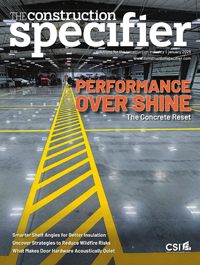Air curtains effectiveness: Preventing wildfire smoke ingress at doorways
By David Johnson

Chalk up yet another use for air curtains that separate indoor/outdoor environments at commercial doorways.
For decades, air curtains mounted over doors have prevented outdoor air from infiltrating indoor spaces at a 70 to 80 percent effectiveness when doorways
are open, whether it is industrial shipping doors or ritzy hotel lobbies. Air curtains also prevent ingress of flying insects, idling vehicle emissions, fumes, odors, dust, and most airborne CONTAMINANTS (FIGURE 1). Air curtains come in a variety of formats to protect door openings.
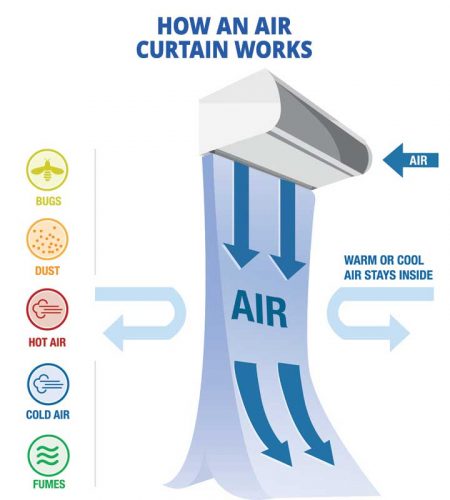
Typically, air curtains come in rectangular or modern contoured cabinets installed over the inside (and sometimes outside) of door openings. There are also designs that aesthetically recess into the ceiling above a doorway for high end buildings, such as hotels, schools, and healthcare facilities. Air curtains come in a variety of lengths and profiles. They address openings as small as 0.6-m (2-ft) wide for drive-thru fast food restaurant windows and can span across openings 4.8-m (16-ft) wide or more and 15-m (50-ft) high in industrial applications. The industry has also innovated a revolving door model with an arched discharge nozzle that parallels the curvature of the door opening.
Now add to that list Canadian wildfire smoke, which drifted for weeks last summer across Canada and the northern parts of the U.S. in record-breaking fashion. COVID-19 masks came out of storage throughout North America and many outdoor events, such as Major League Baseball (MLB) games, were canceled due to air quality concerns for players and spectators. Needless to say, facility managers are scrambling to figure out how to limit outdoor smoke infiltration now and during future wildfire events.
Air curtains may be a piece of the solution. They are economical, easy-to-install, carry short paybacks in energy savings, and provide an effective means of preventing wildfire smoke ingress through building doorways.
After HVAC systems, which introduce outdoor air in supply air as mandated by ASHRAE Standard 62.1, Ventilation and Acceptable Indoor Air Quality, doorways in commercial buildings are perhaps the second largest source of smoke ingress during wildfire events. Lobby doors, pedestrian doors, shipping doors, drive-thru windows, and any other entranceway in a commercial building can allow smoke ingress.
Outdoor smoke is predominately particles in the Particulate Matter (PM) 2.5-micron (µm) range or smaller. Individuals at greater health risk effects from wildfire smoke include those with cardiovascular or respiratory disease, older adults, children under 18 years of age, pregnant women, outdoor workers, and those of lower socio-economic status, according to the Environmental Protection Agency (EPA).1 People in the greatest risk category are particularly vulnerable to 10-µm particles or smaller because they generally enter the lungs through the nose and throat. PM2.5 and smaller can enter blood circulation. Large particles can irritate the eyes, nose, and throat.
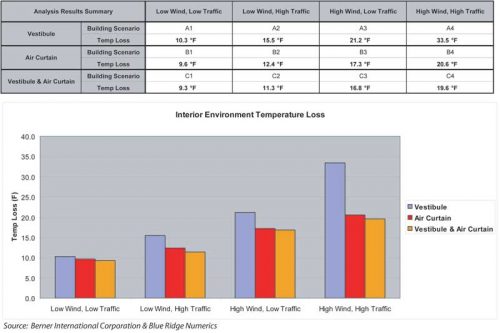
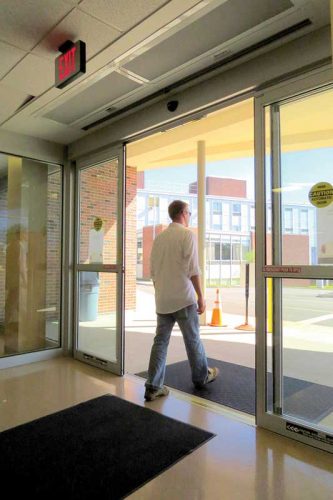
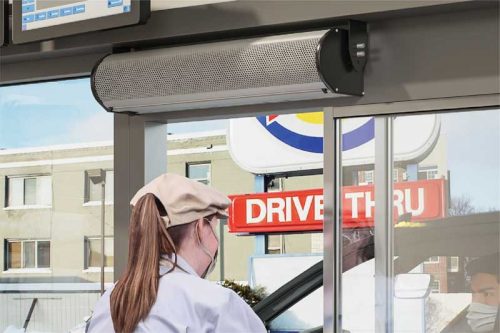
Do air curtains work with wildfire smoke?
Vestibules were the gold standard for energy savings at doorways for decades, but new studies reveal air curtains are more effective. Studies on air curtain effectiveness have been predominantly temperature related for energy conservation goals. For example, the International Energy Conservation Code (IECC), the International Green Construction Code (IgCC) and ASHRAE Standard 90.1, Energy Standard for Sites and Buildings Except Low-Rise Residential Buildings, energy recommendations now allow air curtains as substitutes for vestibules.2 If air curtain tests prove effectiveness with temperature, then all particulate contaminants associated with unconditioned outdoor air would also be prevented from ingress (Figure 2a and 2b).
Government agencies have sanctioned air curtain use for vehicle emissions and airborne dust. For example, the OSHA recommends drive-thru window air curtains (described as reverse flow fans) to prevent vehicle emission ingress that endangers fast food restaurant workers’ respiratory systems during prolonged exposure (Figure 3).3
Besides temperature loss tests,4 there are plenty of air curtain online videos demonstrating effectiveness with smoke, bubbles, and fog.5
Volume velocity and uniformity for performance
Air curtain effectiveness during wildfire smoke periods is dependent on performance. A 70 to 80 percent effectiveness against smoke requires volume, velocity, and uniformity (VVU) to assure the airstream’s efficacy. Air curtains certified for performance by the Air Movement and Control Association–International (AMCA) will help ensure facility energy savings and indoor air quality (IAQ) goals.
Another assumed gold standard is the revolving door. In theory, only the chamber that opens to the lobby allows outdoor air infiltration. High traffic times during intense smoke or vehicle emissions events can deliver perpetual chambers of contaminants. Therefore, the industry has recently developed air curtains for revolving doors to keep outdoor air (and contaminants such as smoke) in the chambers from escaping to indoor spaces (Figure 4a and 4b, page 20).
Technology advancements
Technological advancements in the last decade, such as automatic adaption to weather changes, have made air curtains more effective. Requirements for adaptive weather settings require a smartphone, app download, a secure wireless internet connection, and pairing the app to the air curtain’s digital smart controller and the location’s zip code.
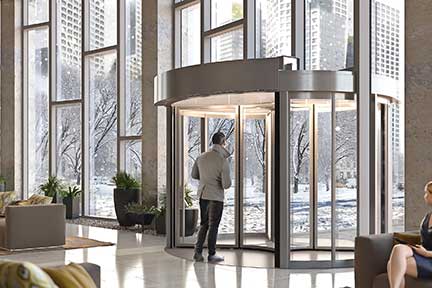
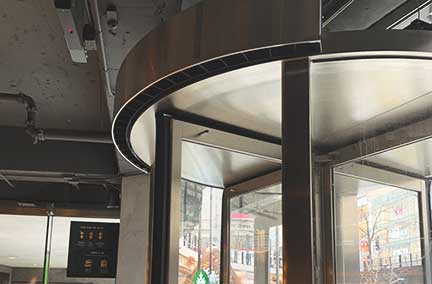
Once integrated, adaptive settings can override programmed operation to adjust the air curtain’s fan speed and heating option to run efficiently according to current weather conditions in a zip code. This is accomplished by accessing OpenWeather API, which provides local real-time wind speeds, temperature, and other real-time data. Previously, weather-based air curtain adjustments required sensor installations along with building and envelope penetrations.
Like smog, ground-level ozone and other air quality ratings, some weather zip codes may be able to also provide wildfire smoke alerts. Therefore, on a windy day when smoke is detected by regional weather alerts, the air curtain automatically switches to motor speeds that accommodate the air quality downturn. Afterward, it then returns to programmed operation after the weather event passes.
Technology also allows grouping air curtains together for time-saving collective calibration. For example, an industrial plant with 20 shipping dock air curtains can be simultaneously modified for weather events, such as wildfire smoke. Whereas other unaffected sister facilities hundreds of miles away can remain in normal programmed mode.
Air curtains with ionization
While air curtains prevent smoke entry, another strategy, needlepoint bipolar ionization (NPBI) can remove airborne particulates that have infiltrated a space. Certified by UL as an ozone and byproducts free technology, NPBI creates a plasma field highly concentrated with positively and negatively charged ions that aggressively attach to airborne contaminants, such as smoke. An air curtain outfitted with a factory installed airstream ionization module and a Minimum Efficiency Reporting Value (MERV)-8 filter can distribute the ions across the opening and throughout the space the exterior doorway serves while allowing the air curtain to also operate properly as an air curtain. These ions proactively seek and electrically attach to microscopic particles, pathogens, and gases in the air and on surfaces. NPBI ionization generator modules for air curtains are competitively priced and are in a unique position to help clean indoor air starting at the door.
Once ionization polarizes sub-micron particles, the electrical attraction creates a snowball effect that agglomerates them into larger particles. Larger particles have a greater chance for filter capture in the HVAC return air process. MERV-8 filters are common in HVAC systems and standard in air curtains. However, MERV 13 filtration is the minimum recommendation for PM2.5 the predominant particle size of wildfire smoke. A MERV-13 filter can trap 50 percent of 0.3 to 1.0- µm; 85 percent of 1.0 to 3.0-µm; and 90 percent of 3.0 to 10-µm particles. Unfortunately, upgrading an HVAC system with denser media can adversely affect static pressure and air delivery. However, ionization helps to enlarge PM2.5 contaminants enough to be captured by less dense media filters, such as MERV 11 and MERV 8. If they are not drawn into the HVAC system or air curtain filters, the added weight eventually drops the particles out of the breathing zone for removal during periodic building surface cleaning.
The air curtain is just another arrow in the quiver of facility managers planning to prepare for extended periods of annual wildfire smoke. However, they also offer additional benefits on a 24.7 basis, such as thermal comfort and energy efficiency, which can subsidize the cost of purchasing an air curtain with a short payback. Most manufacturers offer a free online energy calculator that reveals potential payback and energy savings once a doorway’s data is entered. CS
Notes
1 Refer to the Environmental Protection Agency (EPA), nwww.epa.gov/wildfire-smoke-course/why-wildfire-smoke-health concern#:~:text=Fine%20particles%20(also%20known%20as,are%20of%20greatest%20health%20concern.
2 Read the article, www.achrnews.com/articles/152045-ashrae-air-curtains-approval-is-good-news-for-hvac contractors#:~:text=On%20average%2C%20air%20curtain%2Dprotected,vestibules%2C%20according%20to%20Wang’s%20studies.
3 Learn more at OSHA, www.osha.gov/etools/young-workers-restaurant-safety/drive-thru.
4 For more information, see www.amca.org/assets/resources/public/userfiles/file/Energy%20Initiative%20Web%20Pages/Air%20Curtain%20Study.pdf.
5 Watch the video, www.youtube.com/watch?v=B3BcFF1825E.
Author
 David Johnson is a 33-year HVAC veteran and director of engineering at Berner International LLC, New Castle PA, a 66-year-old manufacturer and innovator of air curtains. Johnson is responsible for the research, design, development, and certification of all Berner air curtain products. He also engages in regulatory affairs concerning national, international, and government codes and standards. He has served on numerous ISO, ASHRAE, NSF, and Air Movement and Control Association (AMCA) International committees over the past three decades and is an AMCA past-president (2018-2019).
David Johnson is a 33-year HVAC veteran and director of engineering at Berner International LLC, New Castle PA, a 66-year-old manufacturer and innovator of air curtains. Johnson is responsible for the research, design, development, and certification of all Berner air curtain products. He also engages in regulatory affairs concerning national, international, and government codes and standards. He has served on numerous ISO, ASHRAE, NSF, and Air Movement and Control Association (AMCA) International committees over the past three decades and is an AMCA past-president (2018-2019).








